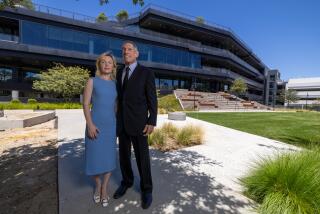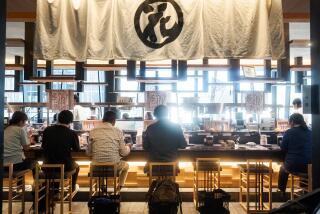Hitachi Goes to College : Technology: The opening of the firm’s research facility at UC Irvine heats up a debate over how much access the Japanese should have to American universities.
- Share via
When it opens its new plum-colored biotechnology laboratory at UC Irvine today, Hitachi Ltd. will become the first Japanese corporation to locate a research facility at the heart of a U.S. university.
The laboratory, called Plumwood House, marks a new approach for Japanese companies trying to tap into the latest technology spawned at American universities. Until now, the Japanese have taken a subtle approach, building research laboratories on the fringes of major U.S. universities, endowing professorships and establishing scholarships at prestigious institutions. Today, Hitachi and other Japanese companies are executing plans formulated years ago to catch up to their U.S. competitors in areas such as biotechnology and computers.
Hitachi’s new $16.5-million lab might have attracted little attention had it been built at another university or outside the UCI campus. But the Japanese electronics giant chose to construct the laboratory at one of the nation’s leading biomedical research centers.
Hiroshi Sumiyama, who will head the Plumwood House facility, says Hitachi’s 40-year lease on the site is intended to forge lasting ties between the company and UCI researchers in fields such as neuroscience and biochemistry in which Hitachi is weak.
“Hitachi has been devoting (research) in recent years to biotechnology, but we are not advanced in this area,” he said. “That’s why the company decided to locate the facility in the United States, (which) is more advanced in biotechnology research. UCI gave us the opportunity to do this.”
Barely two weeks after Hitachi’s new lab opens, another Japanese electronics giant, NEC Corp., plans to open an artificial intelligence laboratory in Princeton, N.J. NEC is spending $75 million for the project, and company officials have said they intend to recruit researchers from Princeton University.
In early fall, Kobe Development Corp., the U.S. subsidiary of Kobe Steel Ltd., is scheduled to open a multimillion-dollar research facility in Palo Alto to develop advanced computer disk drives. Kobe hopes to woo researchers from nearby Stanford University.
A 1986 Labor Department survey of 134 U.S. universities found that foreign sources made up a mere 1% of the $6.8 billion in total university research and development expenditures. The Japanese were the biggest contributors, supplying 9.5% of foreign research funds.
In the past few years, however, Japanese industry has became more visible on U.S. campuses. Japanese firms are targeting major universities engaged in a variety of advanced research, not only in scientific fields but also in the humanities, said Leonard Minsky, executive director of the Washington-based National Coalition for Universities in the Public Interest, a nonprofit group that monitors potential conflicts of interest at U.S. universities. For example, Massachusetts Institute of Technology today has a total of 22 chairs endowed by Japanese corporations, each costing at least $1 million.
“What the Japanese are doing is gaining access to the higher American educational system,” Minsky said. “And the purpose of this is to get access to the most advanced research and technology for commercial use.”
Japanese corporations are not alone in the race for a piece of U.S. education. Japanese schools, eager to expand Japan’s foreign educational programs, have also entered the fray. Last year, administrators of cash-starved Salem College in West Virginia agreed to merge with Tokyo-based Teikyo University, renaming the school Salem-Teikyo University.
As federal funding for university research has dropped during the past decade, schools increasingly have turned to U.S. corporations for money. But as many major U.S. firms spent money fending off hostile takeovers, buying each other and restructuring their operations, their gifts to schools were cut. Meantime, Japanese companies, seeking to speed up research in new technologies, began filling the vacuum left by U.S. corporations and the federal government.
While UCI has welcomed Hitachi with open arms--even allowing the Japanese firm to hire researchers from its medical school--some observers take a dim view of the situation. If the 1980s closed with the Japanese buying stakes in many U.S. companies, some skeptics in Washington and elsewhere are predicting that the 1990s will see the Japanese making forays into U.S. academic and research institutions.
There is concern in Congress about the growing presence of Japanese corporations on U.S. campuses. Testimony during House subcommittee hearings last year showed that some of the nation’s major universities, including MIT, Stanford and UC Berkeley, were making their federally funded research reports available to Japanese corporations for a substantial fee. But some university officials see things differently.
“The Japanese aren’t stealing ideas from us; they’re just more willing to pay the up-front costs of studying, developing and implementing them,” MIT President Paul E. Gray recently wrote in an article in the educational journal Issues in Science & Technology.
One of the main concerns of Minsky and others is that U.S. taxpayers are funding university research that will benefit foreign corporations while further weakening the competitiveness of American industry.
Hitachi’s Sumiyama concedes that “there will be cases in the future where federal or state funds will be used” for lab research.
The results of a House subcommittee study, which is due out this fall, on foreign access to federally funded research could change the rules on joint research projects between U.S. universities and foreign companies.
But some universities are simply grateful to get money for research and don’t care if it comes in U.S. dollars or Japanese yen.
“To train graduate students, we need laboratory space, and the Hitachi building will provide an additional 13,000 square feet to us,” said Christopher Greer, a molecular biologist at UCI. University researchers will occupy the ground floor and Hitachi researchers will have the top two floors.
While there are concerns that Hitachi may get a head start in producing new technologies developed at the new lab, UCI officials are discounting such a scenario. The pact between UCI and Hitachi has been structured as such that “there is no fundamental difference between this arrangement and one that might have existed if Hitachi were located off campus,” said David Schetter, director of UCI’s Office of Research Development.
UCI and Hitachi have worked out a code of conduct that will serve as the blueprint for similar ventures within the statewide University of California system, Schetter said. In cases of joint UCI-Hitachi research, for example, a contract defining the work of each side will be negotiated.
UCI will retain patent rights to all joint research carried out by university staff or involving university equipment, said Jack Jacobs, an adjunct professor at the UCI College of Medicine, who will also be director of basic research at the Hitachi lab. “Any research done solely by Hitachi’s researchers in the building’s second and third floors will belong to Hitachi.”
In 1989, 46.7% of U.S. patents were issued to foreign companies, with nearly half of that going to Japanese corporations. The top four recipients of the patents were Japanese, with Hitachi in the lead.
UCI officials see other benefits to Hitachi’s involvement on the campus. Already, Plumwood House is attracting other Japanese institutions to UCI. The university has held preliminary talks with four major Japanese medical schools about establishing a facility for health sciences research on the campus, said L. Wade Rose, assistant dean at the College of Medicine.
While the debate on Japanese access to U.S. universities raged on, Sumiyama strolled the grounds outside Plumwood House, viewing the landscape. When the project started five years ago, he didn’t think it would cause such a stir, he said.
In 1984, Hitachi awarded UCI a $600,000 grant to lure Masayasu Nomura, a renowned cell biologist, from the University of Wisconsin to a proposed new research center on the UCI campus. But when funding for the new center fell through, Hitachi decided to build a research center itself, Sumiyama said. Nomura will be a full-time UCI faculty member with ties to Plumwood House.
The edifice that houses the Hitachi lab is decorated with soft, shimmering plum-colored tiles. The plum symbolizes education and learning in Japan. Twenty plum trees from Japan have been planted around the lab, along with some American plum trees. The trees circle a fountain that flows into a small Japanese rock garden and pond in a grassy space that joins Plumwood House to the UCI’s medical school.
“This will be a house of wisdom for students here,” Sumiyama said.
More to Read
Sign up for Essential California
The most important California stories and recommendations in your inbox every morning.
You may occasionally receive promotional content from the Los Angeles Times.













